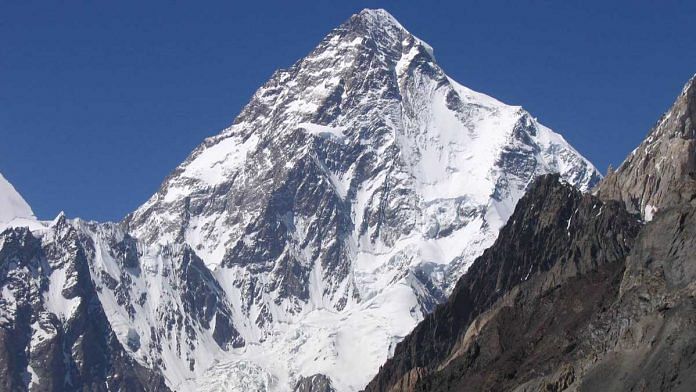New Delhi: Three experienced mountaineers who attempted a winter ascent of the K2, the world’s second highest mountain peak, have been missing since Friday and rescue operations are on to find them.
Pakistani mountaineer Ali Sadpara and his two companions — Iceland’s John Snorri and Chile’s Juan Pablo Mohr — were trying to summit K2 in winter, a feat which has only been achieved once before this, but lost contact with the base camp Friday. Rescue operations by the Pakistani army, which have been going on since the past two days, have failed to locate them.
According to Sadpara’s son, Sajid Ali, the chances of finding the mountaineers alive are next to none now.
Sajid, who was also a part of the expedition but had to abandon it due to some equipment issues, believes that the three “probably met an accident while on their way back after summiting the K2”. He was last with them at the bottleneck Friday — the most technical part of the summit where 11 climbers were killed in an avalanche in 2008.
The rescue team consists of several experts including local high altitude climbers. Aerial reconnaissance was carried out for a second time by Pakistani army helicopters Sunday, which flew to their maximum limit of 7,800 metres to no avail so far.
Also read: Nepal investigating claim two Indian mountaineers ‘faked’ Everest summit
‘Savage mountain’
Regarded by many as a ‘savage mountain’ due to its difficult topography and unpredictable weather, K2 falls in the Karakoram range between the Gilgit-Baltistan region in Pakistan-occupied Kashmir and China and is 8,611-metres (28,250ft) high.
The first attempt to climb K2 was in 1902, by an Anglo-Swiss expedition that managed to reach 18,600 feet (5,670 metres) on the peak’s northeastern crest but failed to reach the peak.
It was first summited in 1954 by Italian climber Ardito Desio’s team and all successful ascents since then have been in summer months.
Only this year did a team of 10 Nepali climbers manage to summit K2 in the winter on 16 January. It has only been tried six times before this and all expeditions ended in failure.
The mission was planned in the summer of 2020, when the coronavirus outbreak was at its peak and had halted such expeditions.
Divided in two teams, the climbers include Nirmal Purja, Gelje Sherpa, Mingma David Sherpa, Mingma G, Sona Sherpa, Mingma Tenzi Sherpa, Prem Chhiri Sherpa, Dawa Temba Sherpa, Killi Pemba Sherpa and Dawa Tenzing Sherpa.
“Brother to brother, shoulder to shoulder, we walked together to the summit whilst singing the Nepali national anthem. We all stopped around 10m before reaching the summit to huddle and make our final steps together as a team to mark this historical feat,” Nirmal Purja tweeted.
Also read: Mt Everest ‘grows’ by 86 cm — how and why mountain heights are recalculated
One in every four climbers that scales K2 dies
Second to only Mount Everest in its height, climbing K2 is attempted only by “serious climbers,” Margret Grebowicz writes in The Atlantic.
The peak is particularly difficult to summit because of various factors. While it is lower than Everest by 200 meters, the topography is much harder to scale and weather conditions far more unpredictable. Besides having very little area that flattens off, unlike Everest, K2 is also prone to avalanches and rock-falls.
One in every four climbers that have attempted to scale K2 lost their lives. In fact, more people have been in outer space than on the peak of this deadly mountain.
“Scaling K2 in winter was perhaps the last great prize of high-altitude mountaineering, a sport born as an expression of national strength among Western European nations in the mid-20th century,” climbing guide Freddie Wilkinson writes in The New York Times.
Discovered by T.G. Montgomery while he was undertaking the British survey of India in 1856 in an attempt to figure out the border between Kashmir and China, K2 was not even given a local name because of how remote and inaccessible it continues to be.
It has no villages where mountaineers can stop at and restock their supplies, forcing them to walk unusually long distances to get to the base camp.
“I actually think it’s very poetic because it sums up a mountain that is very bare, very austere, a perfect pyramid. It’s the very epitome of a mountain,” Mick Conefrey — who made a documentary for the BBC about the mountaineers who climbed K2 — said in an interview.
Grebowicz described the K2 as “the last problem of the Himalayas”, borrowing from a phrase that was used to refer to the once-insurmountable north face of Switzerland’s mountain Eiger, “the last problem of the Alps”.
Also read: Nirmal Purja, the Nepali mountaineer who summitted Everest, Lhotse & Makalu in two days



